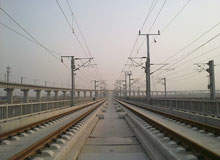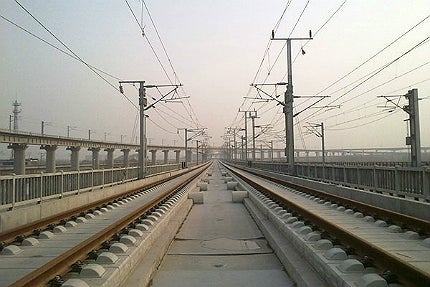

Beijing – Guangzhou high speed line
Beijing – Guangzhou high-speed line, also called the Jingguang High-Speed Railway (HSR), is the world’s longest high-speed line. The 2,298km line is the main north-south high-speed rail corridor in China, connecting the capital city Beijing with Guangzhou, the largest city of Guangdong province. The high-speed line will eventually also connect to Hong Kong via Shenzhen.
Construction of the Beijing – Guangzhou HSR began in 2005 and the line became fully operational in December 2012. The HSR comprises of four sections, which include Beijing-Shijiazhuang-Zhengzhou (693km line opened in December 2012), Zhengzhou-Wuhan (536km line opened in September 2012), Wuhan-Guangzhou (968km line opened in December 2009) and Guangzhou-Shenzhen (102km line opened in December 2011). The 26km Shenzhen-Hong Kong section is expected to be completed by 2016.
The high-speed line is operated with a fleet of CRH380-AL rolling stock, running at a maximum design speed of 350km/h. The operational speed on the line, however, averages 300km/h presently. The travel time between Beijing and Guangzhou has been reduced to eight hours, compared to 22 hours taken on the conventional railway.
The Beijing-Guangzhou high-speed line passes through the Hebei, Henan, Hubei, Hunan and Guangdong province, connecting 28 major Chinese cities. It includes 35 stations along the route and provides interconnections to other high-speed lines, including the Shijiazhuang – Taiyuan HSR, Zhengzhou – Xi’an HSR, Shanghai-Wuhan-Chengdu HSR and Guangzhou-Zhuhai HSR.
See Also:
Shanghai-Wuhan-Chengdu high speed line
Shanghai-Wuhan-Chengdu high speed line, also called the Huhanrong HSR, is the longest and the most advanced among the four east-west high-speed rail corridors under construction in China. The length of the high speed corridor is 2,078km, of which 1,814km was complete as of October 2013. The line is expected to be fully operational in early 2014, with completion of the 264km Chongqing-Lichuan section.
How well do you really know your competitors?
Access the most comprehensive Company Profiles on the market, powered by GlobalData. Save hours of research. Gain competitive edge.

Thank you!
Your download email will arrive shortly
Not ready to buy yet? Download a free sample
We are confident about the unique quality of our Company Profiles. However, we want you to make the most beneficial decision for your business, so we offer a free sample that you can download by submitting the below form
By GlobalDataThe HSR connects Shanghai with four provincial capital cities – Nanjing (the capital of Jiangsu), Hefei (the capital of Anhui), Wuhan (the capital of Hubei) and Chengdu (the capital of Sichuan). It also runs via Chongqing, a major province-level municipality. The line is divided into seven sections, including the 301km Shanghai-Nanjing section, which shares the line with Beijing-Shanghai HSR.
The 377km Yichang-Lichuan section, which was opened in December 2012, is the longest section. The final section due for completion is the Chongqing-Lichuan section, more than 80% of which comprises of tunnels and bridges. The Chongqing-Lichuan is believed to have cost $4.4bn and will operate with an average speed of 200km/h. Test-run on the Yichang-Lichuan section started in October 2013.
Trains on the HSR corridor run at speeds of up to 250km/h except the Shanghai-Nanjing section, which has a designed speed of 350km/h. The corridor will be used for both freight and passenger services. It is expected to reduce the travel time between Shanghai and Chongqing to ten hours, compared to 27 hours currently being taken on conventional rail.
Beijing-Shanghai high speed line
The Beijing-Shanghai high-speed line, also known as the Jinghu HSR, is the longest high-speed corridor in China to be built in a single phase. It is 1,318km long traversing, through four Chinese provinces, namely Hebei, Shandong, Anhui and Jiangsu. It includes 24 stations and connects major cities such as Beijing, Shanghai and Tianjin.
Construction of the more than $30bn Beijing-Shanghai HSR project started in April 2008. Track-laying was completed in November 2010 and it became operational in June 2011. More than 85% of the railway is elevated and the route crosses two major rivers, the Yellow and Yangtze. There are 244 bridges along the line, including the world’s longest, the 164km Danyang-Kunshan Grand Bridge.
The high-speed line has reduced the journey time between Beijing and Shanghai to five hours. It has also increased the annual freight capacity of the parallel conventional railway between Beijing and Shanghai by 50 million tonnes per year. Its ridership reached 100 million by March 2013. More than 90 CRH trains run on the line at a maximum speed of 300km/h.
Beijing-Shanghai line is also the main north-south high-speed corridor in East China. It passes through the cities of Tianjin, Jinan, Xuzhou, Bengbu and Nanjing. It provides interconnection to other high-speed lines, including the Beijing-Harbin HSR, Qingdao-Taiyuan HSR, Xuzhou-Lanzhou HSR and Shanghai-Wuhan-Chengdu HSR. It is also connects Hefei with the 131km Bengbu-Hefei high-speed line.
Beijing-Harbin high speed line
Beijing-Harbin high speed line, also known as the Jingha HSR, is the main high-speed corridor of north-east China. It is one of the passenger dedicated lines of the China Railway High-speed (CRH) system connecting Beijing South Station and Harbin Station. The high speed line is currently under construction and will cover a total length of 1,700km, running parallel to the existing Beijing-Harbin high speed line.
The Beijing-Harbin HSR includes three main sections: the 904 km Harbin-Dalian HSR, the 684km Beijing-Shenyang HSR and the 89km Panjin-Yingkou HSR. Construction works for the corridor commenced in August 2007 and the entire line is expected to be completed in 2015. Harbin-Dalian HSR, the first and the largest section of the corridor, was opened in December 2012. The Panjin-Yingko section opened in September 2013.
The Harbin-Dalian section of the high speed corridor is designed for a maximum speed of 350km/h. Connecting Harbin, the capital of Heilongjiang province, with Changchun, Shenyang and Dalian, the largest port in north-east China, the existing line serves a total of 22 stations. Major stations include Changchun, Shenyang, Shenyang North and Liaoyang.
The normal operating speed on the line is 300km/h, which is reduced to 200km/h during the winter season. The lines are specially designed to cope with extreme temperatures varying from below -40°C in winter to above 40°C in summer. The line served 9.4 million passenger trips, an average of 78,000 per day, within the first three months of its commissioning.
Hangzhou-Fuzhou-Shenzhen high speed line
Hangzhou-Fuzhou-Shenzhen high-speed line, also called the Hangfushen HSR, is a dual-track, electrified, high-speed rail line being developed along the south-eastern coast of China. The line will link the Yangtze River Delta on the East China Sea and Pearl River Delta on the South China Sea when fully completed.
The Hangfushen HSR will connect Hangzhou, the capital city of Zhejiang Province, with Shenzhen, a major city in southern China’s Guangdong Province. The line forms part of the larger Southeast Coast HSR Corridor, which will be approximately 1,745km long passing through three coastal provinces – Zhejiang, Fujian and Guangdong.
The Hangfushen high speed corridor comprises of five sections, of which four are already operational. Construction works for the project commenced in August 2005.
The four operational lines include the 152km Hangzhou-Ningbo section, the 268km Ningbo-Taizhou-Wenzhou section, the 298km Wenzhou-Fuzhou section and the 275km Fuzhou-Xiamen section.
Construction of the last and longest section Xiamen-Shenzhen measuring 502km in length is expected to be completed by early 2014. The works have been underway since November 2007. The line will serve more than 60 stations along its route.
Related content
Top ten fastest trains in the world
Europeans and Asians currently operate the fastest high speed trains in the world, regularly commuting on trains such as the Shanghai Maglev and Harmony CRH 380A.
The future of rail safety in Canada
The tragic derailment at Lac-Mégantic has renewed calls for improved safety standards on Canada’s extensive railways.






